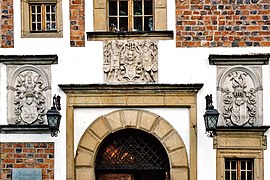Wohnwitz Castle
The Wohnwitz Castle ( Polish: Zamek w Wojnowicach ) is a moated castle in Wojnowice (German Wohnwitz ) in the rural municipality of Miękinia ( Nimkau ) in the Powiat Średzki ( Neumarkt District ) in the Lower Silesian Voivodeship in Poland. It is the oldest continuously used lower castle in Silesia and has largely been preserved in its original structure of a permanent house with a surrounding moat . The Polish term 'Zamek na wodzie' is not a name, but means 'castle on the water', i.e. 'water castle'.
history
The manor Wohnwitz was first mentioned in a document in 1351. At that time, the Bohemian King and later Emperor Charles IV lent the property to Johann Skopp, who was a follower of the Breslau Duke Heinrich VI. was. In 1409 the castle was sold to the barons of Schellendorf, 1511 to Christoph Hornig, then to the Haunold and again to the Hornig.
Nikolaus von Schebitz, governor of the Principality of Wroclaw , began a new building in 1513, which is documented by the building inscription "Im 1513 Bavth mich wonewitz niclas Schewitz". After his death, Lukretia Boner acquired the property, whose first husband, the Flemish Jakob Boner, who was based in Breslau , continued the construction in 1545/46. This process is attested with the inscription "IACOB BONER BAVET MICH". Lucretia's second husband Andreas von Hertwig probably completed the building in 1560. This year can be found on the coat of arms above the Renaissance portal.
From 1590 Friedrich von Sebitz was the owner, 1601 Ernst Schweidinger, who sold it to Carl von Hohberg . After his death, the estate was confiscated by Emperor Rudolf II as a settled fief and in 1609 it was given to the barons of Saurma , who sold it to Veit Rötel von Reichenau in 1649. From 1652 the castle was owned by the von Mudrach family, who bequeathed it to Count Maltzahn , who kept the castle until 1825. In 1894 it came to Egmont von Kramsta . The last owners were the Johnston family.
After the transition to Poland in 1945, the castle was well preserved, apart from a partial dilapidation of the moat. It was renovated from 1974 to 1986. At times it was used by the Polish Art Historians Association. Today it serves as the conference center of the University of Wroclaw .
Building
The Wohnwitz Castle is a four-wing complex with high pitched roofs . Typical of the Silesian Gothic is brick for the masonry and sandstone for the decorative elements of the building. The stepped gables show the plastered panels typical of Silesia between Gothic frames.
The eastern part of the north wing is the oldest part from 1513. The portal walls of this component are still Gothic. The entrance hall of the north wing connects to the assembly from 1513. The adjoining east wing was built in the early 16th century, the other two-story wings come from the third phase of construction.
The inner courtyard, around which the wings are grouped, has a loggia on three arcades on the east side. The building probably had a sgraffito plaster earlier , which was removed in the 19th century. On the upper floor of the north wing there is an arcade hall with a Corinthian central column. Wall decorations from the Renaissance period have been preserved in some rooms .
literature
- Hugo Weczerka (Hrsg.): Handbook of the historical places . Volume: Silesia (= Kröner's pocket edition . Volume 316). Kröner, Stuttgart 1977, ISBN 3-520-31601-3 , p. 572
- Günther Grundmann : Castles, palaces and manor houses in Silesia (= architectural and art monuments of the German East . Volume 1 ). 1982, p. 116-118 .
- Dehio Handbook of Art Monuments in Poland: Silesia. Deutscher Kunstverlag, Munich / Berlin 2005, ISBN 3-422-03109-X , p. 2015 f.
- Arne Franke (Hrsg.): Small cultural history of the Silesian castles . tape 1 . Bergstadtverlag Wilhelm Gottlieb Korn, 2015, p. 99-100 .
Web links
Individual evidence
Coordinates: 51 ° 11 ′ 51.8 ″ N , 16 ° 47 ′ 42.9 ″ E





